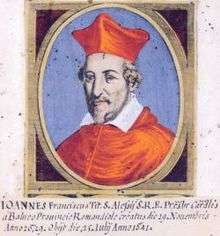Giovanni Francesco Guidi di Bagno
Giovanni Francesco Guidi di Bagno (1578–1641) (also known as Gian Francesco Guidi di Bagno, Gianfrancesco Guidi di Bagno, Giovanni Francesco Bagni or Gianfrancesco de' Conti Guidi di Bagno)[1][2] was an Italian cardinal, brother of cardinal Nicola Guidi di Bagno and nephew of cardinal Girolamo Colonna.
Giovanni Francesco Guidi di Bagno | |
|---|---|
 | |
| Born | 4 October 1578 |
| Died | 24 July 1641 (aged 62) |
| Nationality | Italian |
| Other names | Gian Francesco Guidi di Bagno, Gianfrancesco Guidi di Bagno, Giovanni Francesco Bagni, Gianfrancesco de' Conti Guidi di Bagno |
| Citizenship | Grand Duchy of Tuscany |
| Education | Doctor utriusque juris |
| Parent(s) | Fabrizio Guidi di Bagno, Marquess of Montebello and Laura Colonna, Duchy of Zagarolo |
| Relatives | Brother of cardinal Nicola Guidi di Bagno, nephew of cardinal Girolamo Colonna |
| Religion | Roman Catholic |
| Church | Roman Catholic |
Offices held | Papal Legate; Nuncio |
| Title | Cardinal |
Biography
He was born in Florence (Grand Duchy of Tuscany) 4 October 1578, eldest son of Fabrizio Guidi di Bagno, Marquess of Montebello, Province of Rimini, and Laura Colonna from the Duchy of Zagarolo.
Giovanni Francesco Guidi di Bagno studied law at the universities of Pisa and Bologne, literature and philosophy at the universities of Pisa and Florence and acquired a doctorate in both civil law and church law (Doctor utriusque juris).[3]
In 1596, he went to Rome and was named papal prelate, then he accompanied Pope Clement VIII to Ferrara. In 1597, he was appointed Protonotary apostolic, member of the college of protonotarii apostolici de numero participantium then in 1600 referendary in the Supreme Tribunal of the Apostolic Signatura.
Vice-Legate in the Marches and in Fermo from 1601 to 1606, Giovanni Francesco Guidi di Bagno was Governor of Orvieto (1607), Fano (1608), Fermo (1610) and of the Campagne and Maritime Province (1611).
In 1614, he was elected titular archbishop of Patras and appointed vice-legate of Avignon. The same year he became referendary of the Tribunals of the Apostolic Signature of Justice and of Grace.[1] He was elevated cardinal and reserved in pectore in 1627 and installed in 1631.[2]
Twice nuncio extraordinary in France in the pontificates of Pope Gregory XV and Pope Urban VIII, he was also nuncio at the Brussels court of the Infanta Isabella Clara Eugenia, 1621–1627.[4]
In 1630 in Paris, Cardinal Guidi di Bagno met Gabriel Naudé who became his librarian and secretary and accompanied him in 1631 to Italy,[5] and René Descartes highly appreciated him.[1]
He was appointed bishop of Rieti in 1631 and resigned in 1639.[2]
He died on 24 July 1641 (aged 62) in Rome. He was buried in the church Santi Bonifacio e Alessio.
References
- The Cardinals of the Holy Roman Church Florida International University Libraries
- The Hierarchy of the Catholic Church
- Giampiero Brunelli, Guidi di Bagno, Niccolò, Dizionario Biografico degli Italiani, vol. 61 (2004).
- Guidi di Bagno's correspondence as Apostolic Nuncio to Flanders has been calendared in the Analecta Vaticano-Belgica as Correspondance du nonce Giovanni-Francesco Guidi di Bagno, 1621-1627, edited by Bernard De Meester (2 vols., Brussels, 1938).
- Paul Oskar Kristeller (1993). Studies in Renaissance Thought and Letters. Ed. di Storia e Letteratura. pp. 615–. ISBN 978-88-8498-333-6.
| Catholic Church titles | ||
|---|---|---|
| Preceded by Alessandro Piccolomini |
Titular Archbishop of Patrae 1614–1641 |
Succeeded by Ciriaco Rocci |
| Preceded by Lucio Sanseverino |
Apostolic Nuncio to Flanders 1621–1627 |
Succeeded by Fabio Lagonissa |
| Preceded by Bernardino Spada |
Apostolic Nuncio to France 1627–1630 |
Succeeded by Alessandro Bichi |
| Preceded by Bonifazio Bevilacqua Aldobrandini |
Bishop of Cervia 1627–1635 |
Succeeded by Francesco Maria Merlini |
| Preceded by Roberto Ubaldini |
Cardinal-Priest of Sant'Alessio 1631–1641 |
Succeeded by Mario Theodoli |
| Preceded by Gregorio Naro |
Bishop of Rieti 1635–1639 |
Succeeded by Giorgio Bolognetti |